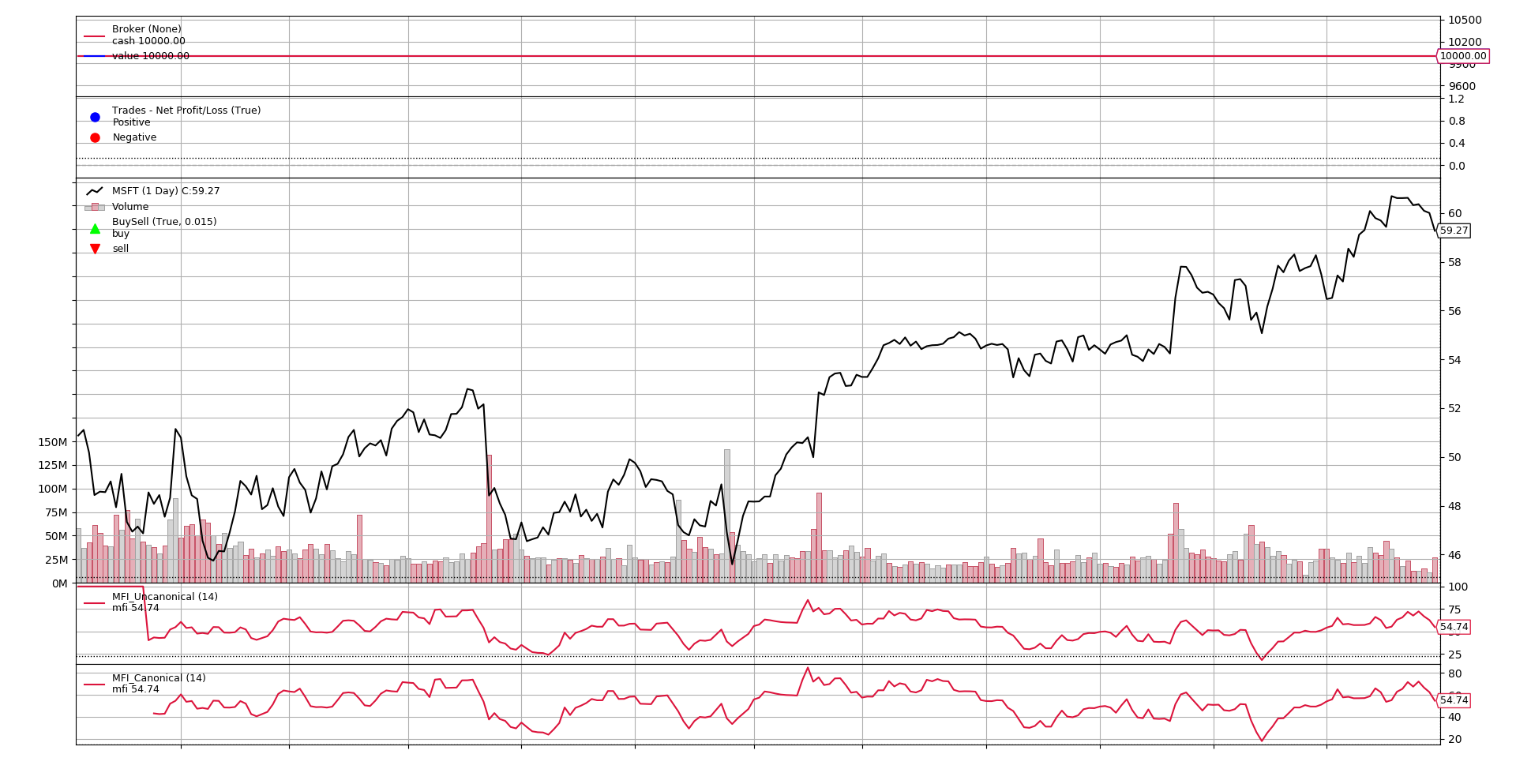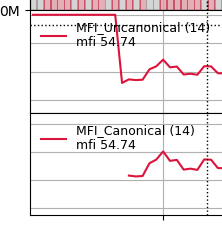Canonical vs Non-Canonical Indicators
The question has shown up several times more or less like this:
- How is this or that best/canonically implemented with backtrader?
Being one of the goals of backtrader to be flexible to support as many situations and use cases as possible, the answer is easy: "In at least a couple of ways". Summarized for indicators, for which the question most often happens:
-
100% declarative in the
__init__method -
100% step-by-step in the
nextmethod -
Mixing both of the above for complex scenarios in which the declarative part cannot cover all needed calculations
A quick view of the built-in indicators in backtrader reveals that all of them are implemented in a declarative manner. The reasons
-
Easier to do
-
Easier to read
-
More elegant
-
Vectorized and even-based implementations are automatically managed
What ?!?! Auto-implemented Vectorization??
Yes. If an indicator is implemented entirely inside the __init_ method, the
magic of metaclasses and operator overloading in Python will deliver the
following
-
A vectorized implementation (default setting when running a backtest)
-
An event-based implementation (for example for live trading)
On the other hand and if any part of an indicator which is implemented in the
next method:
-
This is the code directly used for an event-based run.
-
Vectorization will be simulated by calling the
nextmethod in the background for each data pointNote
This means that even if a particular indicator does not have a vectorized implementation, all others which have it, will still run vectorized
Money Flow Index: an Example
Community User @Rodrigo
Brito posted a
version of the "Money Flow Index" indicator which used the next method for
the implementation.
The code
class MFI(bt.Indicator):
lines = ('mfi', 'money_flow_raw', 'typical', 'money_flow_pos', 'money_flow_neg')
plotlines = dict(
money_flow_raw=dict(_plotskip=True),
money_flow_pos=dict(_plotskip=True),
money_flow_neg=dict(_plotskip=True),
typical=dict(_plotskip=True),
)
params = (
('period', 14),
)
def next(self):
typical_price = (self.data.close[0] + self.data.low[0] + self.data.high[0]) / 3
money_flow_raw = typical_price * self.data.volume[0]
self.lines.typical[0] = typical_price
self.lines.money_flow_raw[0] = money_flow_raw
self.lines.money_flow_pos[0] = money_flow_raw if self.lines.typical[0] >= self.lines.typical[-1] else 0
self.lines.money_flow_neg[0] = money_flow_raw if self.lines.typical[0] <= self.lines.typical[-1] else 0
pos_period = math.fsum(self.lines.money_flow_pos.get(size=self.p.period))
neg_period = math.fsum(self.lines.money_flow_neg.get(size=self.p.period))
if neg_period == 0:
self.lines.mfi[0] = 100
return
self.lines.mfi[0] = 100 - 100 / (1 + pos_period / neg_period)
Note
Kept as originally posted including the long lines for which one has to scroll horizontally
@Rodrigo Brito already
notices that the usage of temporary lines is (all lines except mfi) is
something which probably admits optimization. Indeed, but in the humble opinion
of the author*, actually everything does admit a bit of optimization.
To have common working grounds, one can use the "Money Flow Index" definition by StockCharts and see that the implementation above is good. Here is the link:
With that in the hand, a quick Canonical implementation of the MFI
indicator
class MFI_Canonical(bt.Indicator):
lines = ('mfi',)
params = dict(period=14)
def __init__(self):
tprice = (self.data.close + self.data.low + self.data.high) / 3.0
mfraw = tprice * self.data.volume
flowpos = bt.ind.SumN(mfraw * (tprice > tprice(-1)), period=self.p.period)
flowneg = bt.ind.SumN(mfraw * (tprice < tprice(-1)), period=self.p.period)
mfiratio = bt.ind.DivByZero(flowpos, flowneg, zero=100.0)
self.l.mfi = 100.0 - 100.0 / (1.0 + mfiratio)
One should be able to immediately notice
-
A single line
mfiis defined. No temporaries are there. -
Things seem cleaner with no need for
[0]array indexing -
No single
ifhere or there -
More compact whilst more readable
Should one plot a graph of both run against the same data set, it would look like this
The chart shows that both the Canonical and Non-Canonical versions show the same values and development, except at the beginning.
-
The Non-Canonical version is delivering values from the very start
-
It is delivering non-meaningful values (100.0 until it deliver 1 extra value which is also not good) because it cannot properly deliver
In contrast:
-
The Canonical version automatically starts delivering values after the minimum warm-up period has been reached.
-
No human intervention has been needed (it must for sure be "Articifial Intelligence" or "Machine Learning", ... pun intended)
See a close-up picture of the affected area
Note
One could of course try to alleviate this situation in the Non-Canonical version by doing this:
- Subclassing from
bt.ind.PeriodNwhich already has aperiodparam and knows what to do with it (and callingsuperduring__init__)
Notice also that the Canonical version does also account, like the
step-by-step next code for a possible division-by-zero situation in the
formula.
if neg_period == 0:
self.lines.mfi[0] = 100
return
self.lines.mfi[0] = 100 - 100 / (1 + pos_period / neg_period)
whereas this is the other way to do it
mfiratio = bt.ind.DivByZero(flowpos, flowneg, zero=100.0)
self.l.mfi = 100.0 - 100.0 / (1.0 + mfiratio)
Instead of having many lines, a return statement and different assignments to
the output line, there is s single declaration of the mfiratio calculation
and a single assignment (following the StockCharts formula) to the output
line mfi.
Conclusion
Hopefully, this sheds some light as to what the differences can be when
implementing something in the Canonical (i.e.: declarative in __init_) or
Non-Canonical way (step by step with array indexing in next)

